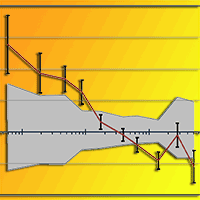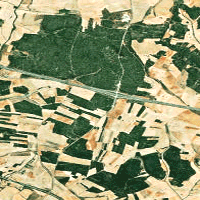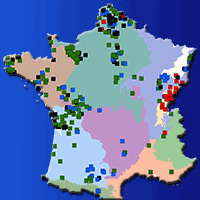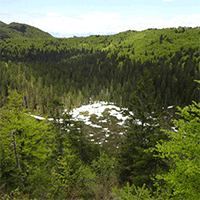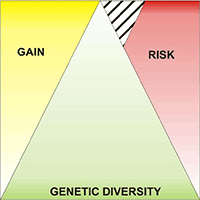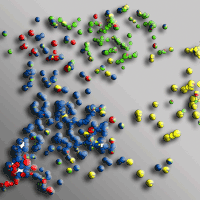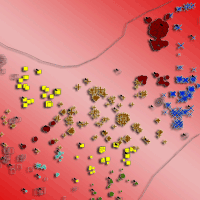
Clonal structure and dynamics of peripheral Populus tremula L. populations
Dolores Cristóbal (1-2), Pablo Martínez-Zurimendi (2-3) , Inés Villamediana (1), Josu Ciriza (1), Javier Villar (1), Nikos Nanos (4), Rosario Sierra-de-Grado (1-2)
iForest - Biogeosciences and Forestry, Volume 7, Issue 3, Pages 140-149 (2014)
doi: https://doi.org/10.3832/ifor0971-007
Published: Jan 13, 2014 - Copyright © 2014 SISEF
Research Articles
Abstract
Native Populus tremula L. populations at the south-western limit of the species’ range are threatened by the anthropic reduction of their habitats and by climate change. In these areas, P. tremula forms small and multiclonal populations. Knowledge of the structures and dynamics of these populations is essential to design effective conservation programs. The clonal spatial and ramet age distributions of three natural populations in north-western Spain were studied. Trees with diameter > 3 cm at breast height were mapped and their age identified. Multilocus genotypes based on 11 isoenzymatic loci were obtained for a sample of 90-106 evenly distributed trees per population. Clonal assignment of the remaining trees in each stand was interpolated using geostatistical methods. All three stands were multiclonal, with higher clonal diversity than that reported in northern populations, and no genotype was detected in more than one stand. Most clones exhibited aggregated distributions, but some scattered clones were also found. The clonal structures of the stands are consistent with the hypothesis that recruitment is absent inside the stand. A combined analysis of ages and genotypes revealed cycles of regrowth in which each clone experienced varying degrees of success in generating new ramets. These degrees of success could be the consequence of varying abilities for vegetative propagation among genotypes. Geostatistical interpolation can be a useful tool for the elaboration of clonal maps, thus reducing the costs of sampling and genotyping, but further research is needed to define the optimum scale of sampling for accurate clonal assignment. For P. tremula conservation programs based on clonal material, small plantations with relatively few clones (approximately 10) provide an appropriate strategy if the metapopulation is maintained at a sufficient level of diversity. The set of clones used for plantations and ex-situ collections should consider both the most abundant and the least frequent clones to avoid a biased selection.
Keywords
Populus tremula, Clonal Structure, Genetic Diversity, Population Dynamics, Conservation Plans
Authors’ Info
Authors’ address
Inés Villamediana
Josu Ciriza
Javier Villar
Rosario Sierra-de-Grado
Department of Plant Production and Forest Resources, Universidad de Valladolid, ETSIIAA, Avda. De Madrid 44, 34071 Palencia (Spain)
Pablo Martínez-Zurimendi
Rosario Sierra-de-Grado
Sustainable Forest Management Research Institute UVa-INIA (Spain)
ECOSUR, Villahermosa (México)
Escuela Técnica Superior de Ingenieros de Montes, Universidad Politécnica de Madrid (Spain)
Corresponding author
Paper Info
Citation
Cristóbal D, Martínez-Zurimendi P, Villamediana I, Ciriza J, Villar J, Nanos N, Sierra-de-Grado R (2014). Clonal structure and dynamics of peripheral Populus tremula L. populations. iForest 7: 140-149. - doi: 10.3832/ifor0971-007
Academic Editor
Andrea Piotti
Paper history
Received: Feb 12, 2013
Accepted: Sep 30, 2013
First online: Jan 13, 2014
Publication Date: Jun 02, 2014
Publication Time: 3.50 months
Copyright Information
© SISEF - The Italian Society of Silviculture and Forest Ecology 2014
Open Access
This article is distributed under the terms of the Creative Commons Attribution-Non Commercial 4.0 International (https://creativecommons.org/licenses/by-nc/4.0/), which permits unrestricted use, distribution, and reproduction in any medium, provided you give appropriate credit to the original author(s) and the source, provide a link to the Creative Commons license, and indicate if changes were made.
Web Metrics
Breakdown by View Type
Article Usage
Total Article Views: 57180
(from publication date up to now)
Breakdown by View Type
HTML Page Views: 48087
Abstract Page Views: 3124
PDF Downloads: 4394
Citation/Reference Downloads: 35
XML Downloads: 1540
Web Metrics
Days since publication: 4375
Overall contacts: 57180
Avg. contacts per week: 91.49
Citation Metrics
Article Citations
Article citations are based on data periodically collected from the Clarivate Web of Science web site
(last update: Mar 2025)
Total number of cites (since 2014): 5
Average cites per year: 0.42
Publication Metrics
by Dimensions ©
Articles citing this article
List of the papers citing this article based on CrossRef Cited-by.
References
Sampling the gene pools of forest trees for ex situ conservation. In: “Forest conservation genetics: principles and practice” (Young A, Boshier D, Boyle T eds). CSIRO Pubishing, Melbourne, Australia, pp. 185-196.
Gscholar
Geostatistics: modeling spatial uncertainty. John Wiley & Sons, New York, USA, pp. 720.
Gscholar
Taxonomic identification and genetic structure of populations of the Populus tremula L., Populus alba L. and P. x canescens (Ait.) Sm. complex using morphological and electrophoretical markers. In: “Population genetics and genetic conservation of forest trees” (Baradat Ph et al. eds). SPB Academic Publishing, Amsterdam, the Netherlands, pp. 113-119.
Gscholar
Genetic variation and conservation of the native aspen (Populus tremula L.) resource in Scotland. MS thesis, Edinburgh University, Edinburgh, UK, pp. 267.
Gscholar
Conservation and diversity of Populus species in Castilla y León, Spain. In: Proceedings of the Meeting “Forest Ecosystem: Genomics and Adaptation”. San Lorenzo de El Escorial (Madrid, Spain) 9-11 June 2010, pp. 233.
Gscholar
The genecology of Populus. In: “Biology of Populus and its implications for management and conservation” (Stettler RF, Bradshaw HD, Heilman PE, Hinckley TM eds). NCR Research Press, Ottawa, Ontario, Canada, pp. 33-55.
Gscholar
Isatis software. Geovariances and Ecole des Mines de Paris, Paris, France.
Gscholar
Geostatistics for natural resources evaluation. Oxford University Press, New York, USA, pp. 483.
Gscholar
Genetic considerations for the restoration of riparian populations. In: “In situ conservation of Populus nigra” (Lefèvre F, Barsoum N, Heinz B, Kalba D, Rotach P, Vries SMG, Turok J eds). International Plant Genetic Resources Institute, FAO, Rome, Italy, pp. 25-35.
Gscholar
Sucker production from root cuttings of Populus tremula in relation to growing conditions. Scandinavian Journal of Forest Research 3 (1-4): 75-82.
Gscholar
Strategies for the conservation of a pioneer tree species, Populus nigra L., in Europe. Genetics Selection Evolution 30 (1): S181-S196.
Gscholar
In situ conservation of Populus nigra. International Plant Genetic Resources Institute, FAO, Rome, Italy, pp. 58.
Gscholar
A comparision of isozyme and morphological markers to assess the within population variation in small populations of European aspen (Populus tremula L.) in Spain. Silvae Genetica 53 (5-6): 227-233.
Gscholar
Diccionario geográfico estadístico histórico. Diputación Provincial de Palencia, Palencia, Spain, pp. 240. [in Spanish]
Gscholar
Forest risk in Spain under future climate change. In: “Atlas of Biodiversity risk - from Europe to the Globe from Stories to Maps” (Settele J, Penev L, Georgiev T, Grabaum R, Grobelnik V, Hammer V, Klotz S, Kühneds I eds). Pensoft Publishers, Sofia, Bugaria and Moscow, Russia, pp. 72-73.
Gscholar
Aspen woodlands: a case for conservation. Native Woodlands Advisory for Scotland, Forestry Comission, Edinburgh, Scotland, UK.
Gscholar
General considerations and basic strategies. In: “In situ Conservation of Populus nigra” (Lefèvre F, Barsoum N, Heinze B, Kajba D, Rotach P, Vries SMG, Turok J eds). International Plant Genetic Resources Institute, FAO, Rome, Italy, pp. 8-15.
Gscholar
Reproducción sexual y diversidad genética de Populus tremula. In: “El álamo temblón (Populus tremula L.) Bases para su cultivo, gestión y conservación” (Sierra de Grado R ed). MundiPrensa Libros SA, Madrid, Spain, pp. 151-166. [in Spanish]
Gscholar
Microevolution in clonal plants. In: “Population biology and the evolution of clonal organisms” (Jackson J, Buss L, Cook RG eds). Yale University Press, New Haven, USA, pp. 107-152.
Gscholar
Introduction. In: “In situ conservation of Populus nigra” (Lefèvre F, Barsoum N, Heinz B, Kalba D, Rotach P, Vries SMG, Turok J eds). International Plant Genetic Resources Institute, FAO, Rome, Italy, pp. 5-7.
Gscholar
Visualization and interpretation of plant isozymes. In: “Isozymes in plant biology” (Soltis DE, Soltis PS eds). Dioscorides Press, Portland, OR, USA, pp. 5-45.
Gscholar

